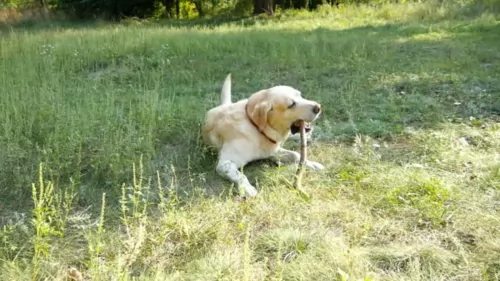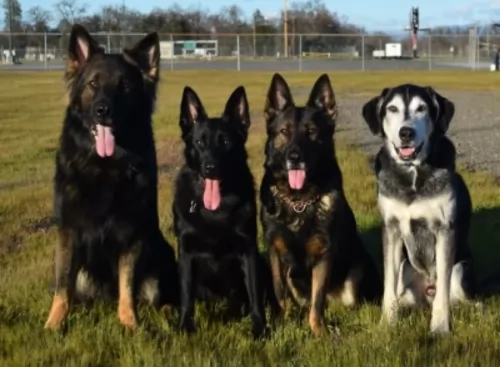 Petzlover
PetzloverCircassian Orloff Wolfhound is originated from Russia but Shepard Labrador is originated from United States. Circassian Orloff Wolfhound may grow 14 cm / 6 inches higher than Shepard Labrador. Both Circassian Orloff Wolfhound and Shepard Labrador are having almost same weight. Both Circassian Orloff Wolfhound and Shepard Labrador has almost same life span. Both Circassian Orloff Wolfhound and Shepard Labrador has almost same litter size. Circassian Orloff Wolfhound requires Moderate Maintenance. But Shepard Labrador requires Low Maintenance
Very little is known of the history and development of the Circassian Orloff Wolfhound. It is suspected that it is related to the Hare Hound, Deerhound and the Greyhound. They were taken from Siberia to the Circassian southern mountains to hunt hare and small prey. The breed is also like the Borzoi but more intelligent and it is much faster than the other sighthounds.
The color and some other minor characteristics have evolved over the centuries to be different from the Siberian that was originally brought to the mountains. All the historical data suggests that the original parents of all these sighthounds was the Celtic Greyhound
 The Labrador/German Shepherd mix, known as the Shepard Labrador was no doubt first bred in the United States from two very popular dog breeds - the Labrador and the German Shepherd.
The Labrador/German Shepherd mix, known as the Shepard Labrador was no doubt first bred in the United States from two very popular dog breeds - the Labrador and the German Shepherd.
Breeders of this dog were looking to bring about a dog that could be an exceptional companion with characteristics from both breeds.
Also referred to as the Sheprador, the dog will surely have an amazing temperament.
The Circassian Orloff Wolfhound had many of the characteristics of any sighthound. He has strong straight legs and they are longer than most sighthounds which allows the Circassian to run amazingly fast. The head is long, the muzzle is wide, and the eyes are large and dark. They have a deep chest and medium tail. They also have a graceful and aristocratic demeanor.
 With the Shepard Labrador, because the puppies come from two pure breeds – the Labrador and the German Shepherd, there is no really knowing how your pet will turn out. There is therefore no standard appearance.
With the Shepard Labrador, because the puppies come from two pure breeds – the Labrador and the German Shepherd, there is no really knowing how your pet will turn out. There is therefore no standard appearance.
Some will have floppy ears like the Labrador, some erect ears like the German Shepherd. The tail will always be long. The coat will always be thick and be short to medium in length. Some puppies will be born with a fawn shade and others will have the dark colors of the German Shepherd. Some will have a mix of colors.
They will be fairly large dogs standing at between 53 and 62m in height and weighing between 23 and 36kg.
Between two such splendid dog breeds, you’re guaranteed to get a wonderful temperament – after all, that's why the two breeds were brought together. Your Shepard Labrador will be friendly, playful, social,smart, courageous, loving, loyal and energetic, just loving to be around his human family.
These dogs get on well with children, and with training and socialization will get on well with other pets in the home. This dog really makes a splendid family pet.
Fun and games are right in this breeds wheelhouse. They love to run. They need to run. Their activity level is very high, and they need lots of space and regular exercise. They are very intelligent and need mental stimulation as well. They are great at lure coursing and they love racing of course
 There are studies that show that dogs provide us with so many good things – companionship, comfort and relaxation.They provide us with entertainment too because some of them are so amusing with their antics.
There are studies that show that dogs provide us with so many good things – companionship, comfort and relaxation.They provide us with entertainment too because some of them are so amusing with their antics.
The Shepard Labrador is like that – he is social, friendly, loving and devoted and by bringing him into your home, you’re signing up for 10 – 14 years of sheer pleasure, less stress and superb companionship.
Again, little is known about the health of this ancient breed, except to propose that it faces many of the same challenges as the Greyhound. This would include skin irritation, bloat, osteosarcoma and esophageal achalasia.
Esophageal achalasia is rare and affects the esophagus’ muscles. The upper muscles can’t relax and that causes the lower muscle or sphincter not to open and no food can get to the stomach.
 The Shepard Labrador is a healthy dog breed, and with the right nutrition and exercise can reach 10 to 14 years of age. There are always going to be those common dog illnesses that many dogs succumb to. Some of them are hip dysplasia, cancer, skin problems and parasites.
The Shepard Labrador is a healthy dog breed, and with the right nutrition and exercise can reach 10 to 14 years of age. There are always going to be those common dog illnesses that many dogs succumb to. Some of them are hip dysplasia, cancer, skin problems and parasites.
Hip dysplasia is a condition where parts of the hip joints don’t fit properly together. This creates a situation where there is abnormal wear and tear on the joints. It can lead to arthritis even and pain for your dog.
The tapeworm is a parasite spread to dogs but also to people, and it is through the ingestion of infected fleas. You can often detect this when you discover parts of the worm crawling in your dog’s bowel movements or they can be around the anus. You can suspect this when you see your pet losing weight and having diarrhea. Speak to your vet about how to control fleas with your dog.
This is a fatal disease where dogs are infected through bites from rabid animals. You’ll notice horrible behavioral changes in your dog. Unfortunately with this terrible disease, once symptoms appear, it is virtually too late for treatment.
This dog is a lean running machine. Do not overfeed. It is also better to feed him two to three times a day in smaller portions rather than one large meal.
They tend to be allergic to insecticide and anesthesia. It’s best not to treat your yard for insects if your Circassian Orloff Wolfhound will be out in it.
Fun and games are right in this breeds wheelhouse. They love to run. They need to run. Their activity level is very high, and they need lots of space and regular exercise. They are very intelligent and need mental stimulation as well. They are great at lure coursing and they love racing of course.
 ◆Brush the coat of your Shepard Labrador twice a week to rid the coat of loose hairs and to keep the coat shiny ad healthy. Many people add in the Omega 3/6 oils to the dog’s food to ensure a healthy skin and coat.
◆Brush the coat of your Shepard Labrador twice a week to rid the coat of loose hairs and to keep the coat shiny ad healthy. Many people add in the Omega 3/6 oils to the dog’s food to ensure a healthy skin and coat.
◆Check the ears and eyes for infection. Make sure there are no signs of redness and discharge.
◆Check the inside of your pet’s mouth He has no way of telling you that a rotten tooth in the mouth is causing hi tremendous pain and affecting the his health.
◆Provide your pet with a warm, dry place to sleep. Make sure if he is outdoors that he has both sun and shade.
◆Feed your pet the best food there is. Your Shepard Labrador will no doubt be served commercially manufactured food. There are good and bad varieties. Make sure it is one of the better brands to ensure you don’t end up feeding your pet foods packed full of unhealthy ingredients such as colorants, preservative and fillers.
Try and include some home-made food to the diet. Boiled chicken, brown rice or pasta and spinach, sweet potatoes and carrots are a healthy choice for your pet as it won’t upset your dog’s digestive system.
Also try and include some raw meat into the diet as this can help in fighting off skin problems. Ensure your Shepard Labrador always has access to a bowl of fresh, cool water.